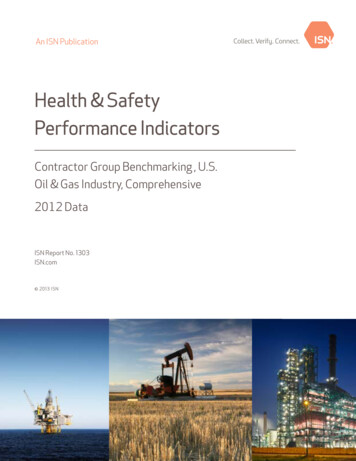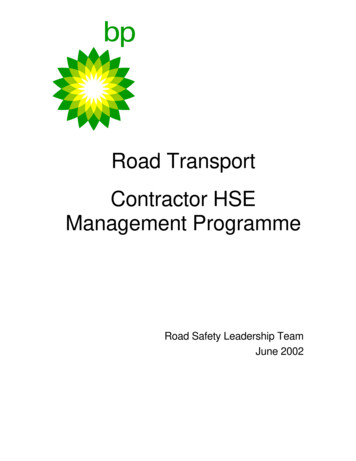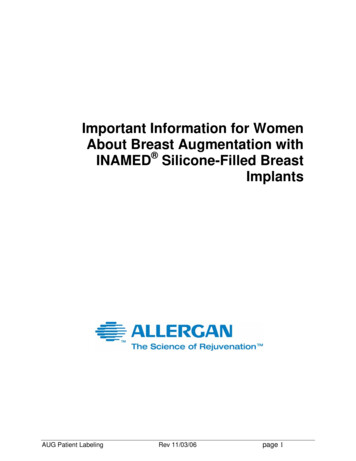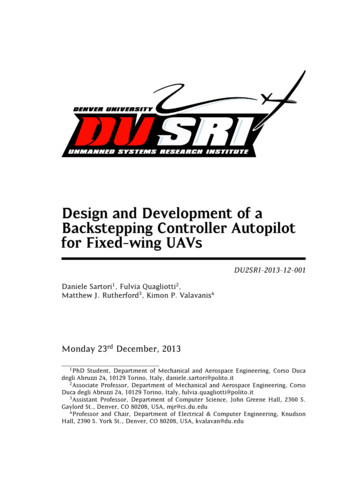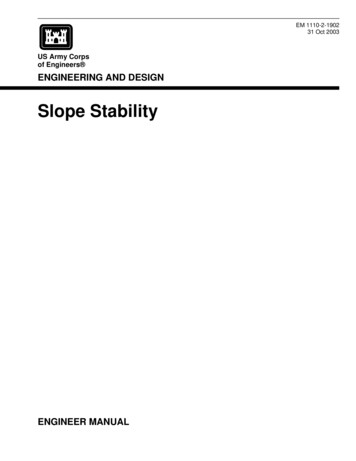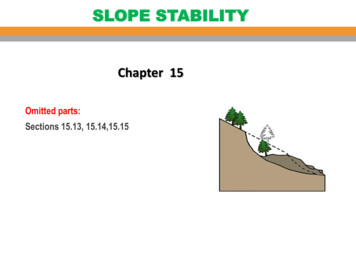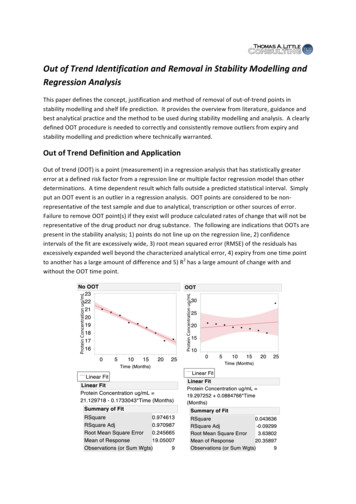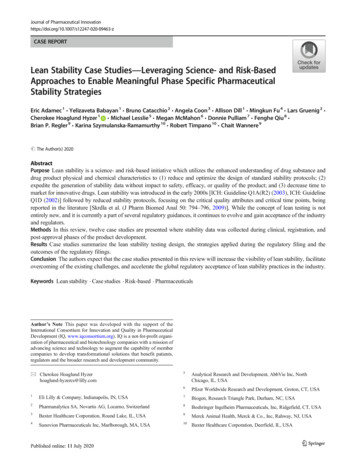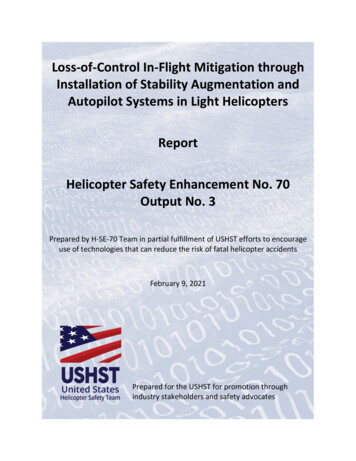
Transcription
Loss‐of‐Control In‐Flight Mitigation throughInstallation of Stability Augmentation andAutopilot Systems in Light HelicoptersReportHelicopter Safety Enhancement No. 70Output No. 3Prepared by H‐SE‐70 Team in partial fulfillment of USHST efforts to encourageuse of technologies that can reduce the risk of fatal helicopter accidentsFebruary 9, 2021Prepared for the USHST for promotion throughindustry stakeholders and safety advocates
Loss‐of‐Control Mitigation through SAS and Autopilot SystemsContents1.Background . 42.Scope . 43.Introduction . 54.Safety Data . 65.Historical Context – IFR Certification . 76.AFCS Functionality . 86.1Basic AFCS Functionality . 8A.Trim . 8B.Stability Augmentation Systems (SAS) . 9C.Basic Coupled Modes . 96.2Advanced AFCS Functionality . 9A.IFR Coupled Modes . 9B.Additional Safety‐Enhancing Modes . 107.AFCS Performance and Safety Considerations . 118.Technology . 139.Certification Challenges and Alternatives . 159.1Performance‐Based Standards . 159.2Nonrequired Safety‐Enhancing Equipment . 159.3Safety Continuum . 1610. State of the Market . 1610.1 Rotary‐Wing Airframe Original Equipment Manufacturer (OEM) Solutions . 1710.2 Third‐Party Solutions: Supplemental Type Certificate (STC) Retrofit Systems . 1710.3 Emerging Solutions for Consideration . 17A.Special Class of Aircraft Certification . 17B.Integration of UAS/UAM/eVTOL Stabilization Solutions . 18C.Current UAS Industry Technology Solutions . 1811. Conclusions . 1912. Recommendations . 1913. Annex A: Advanced Flight Control Systems . 21A.1Trim . 21A.2Stability Augmentation . 2114. Annex B: References . 24February 9, 2021Page 2 of 39
Loss‐of‐Control Mitigation through SAS and Autopilot Systems15. Annex C: Acronyms . 2516. Annex D: NTSB Accident Reports Supporting this Safety Enhancement . 27NTSB Report #1 . 28NTSB Report #2 . 29NTSB Report #3 . 30NTSB Report #4 . 32NTSB Report #5 . 33NTSB Report #6 . 36NTSB Report #7 . 37NTSB Report #8 . 3817. Annex E: US Helicopter Safety Team . 39USHST . 39H‐SE 70 Team . 39Principal Authors . 39Contributing Authors, Consultants, and Editors . 39February 9, 2021Page 3 of 39
Loss‐of‐Control Mitigation through SAS and Autopilot Systems1.BackgroundThe US Helicopter Safety Team (USHST) is a volunteer team of US government and industry stakeholdersformed to improve the safety of civil helicopter operations in the National Airspace System. The USHST’svision is a civil US registered helicopter community with zero fatal accidents. Through data‐drivenaccident and flight safety data analyses, the USHST’s mission is to understand the US helicoptercommunity’s safety issues and use that understanding to promote the development andimplementation of voluntary, consensus‐based risk mitigations called helicopter safety enhancements(H‐SEs). This document provides us with a clear example of how the USHST can leverage industrypartnerships to develop, implement, and promote helicopter safety enhancements (H‐SEs) that canreduce US civil helicopter fatal accident rates. For additional information about the USHST, refer toAnnex E.2.ScopeThe USHST established H‐SE 70: Stability Augmentation System (SAS) / Autopilot as a desired safetyenhancement that recommended technology and equipment solutions to reduce fatal rotorcraftaccidents. The initial scope summary stated: “Industry and Federal Aviation Administration (FAA) toencourage development and installation of a stability augmentation system (SAS) and/or autopilot inlight helicopters.”While several concurrent USHST efforts seek to address other critical safety enhancements, this whitepaper focuses on the continued development and integration of stability augmentation and autopilotsystems in rotorcraft. Emerging technology solutions can reduce the complexity, weight, and cost oftraditional automatic flight control systems.The Statement of Work (SOW) for this H‐SE specifically stated the following:The USHST Safety Analysis Team identified loss of control in flight (LoC‐I) as one of thetop three most common occurrence categories of fatal civil helicopter accidents in their2009‐2013 dataset. Current light helicopters have flight characteristics that arechallenging and demanding of pilot workload. The purpose of this H‐SE is to increasesafety by encouraging the development and installation of a stability augmentationsystem (SAS) or autopilot devices that increase the flight stability of light helicopters.SAS/autopilot devices must be designed to reduce the incidence of loss of control in flight(LoC‐I) and should consider new and retrofit configurations not currently supported bysimilar devices. The devices should also consider low visibility, low ceilings, andunintended IMC, and preferably enhance safety without requiring pilot action. ASAS/autopilot device may embody commercial off‐the‐shelf (COTS) pneumatic,electronic, micro‐electromechanical systems (MEMS), or mechanical devices to sense orcontrol helicopter motion.The following SOW outputs, described as performance goal indicators, were identified for H‐SE 70:1. USHST to coordinate the formation of the H‐SE 70 team.February 9, 2021Page 4 of 39
Loss‐of‐Control Mitigation through SAS and Autopilot Systems2. Meet with the FAA regarding certification pathways for SAS/autopilot technology for lighthelicopters.3. Draft a white paper that identifies the need and pathways to certification for SAS/autopilottechnology for light helicopters. White paper should discuss available options as well as futuretechnological needs.4. Promote the white paper to the FAA (including Parts 27/29 rewrite working groups) andindustry.Note 1: The H‐SE 70 team modified the scope slightly to focus solely on Part 27 integration to improvethe likelihood of follow‐on FAA action. Some information may, however, facilitate future efforts of Part29 stakeholders seeking similar objectives.Note 2: The USHST acknowledges that further refinement and implementation of concepts, solutions,and capabilities proposed in this document require joint development by qualified government andindustry stakeholders.3.IntroductionHelicopters are generally more prone to loss‐of‐control (LoC) accidents than airplanes due to theirinherent instability and lack of mechanical trim. Most airplanes certified under FAA requirements aretypically designed with inherent stability and trim characteristics, requiring no additional augmentationor automatic flight control system, such as an autopilot. Consequently, in moments of disorientation, afixed‐wing pilot can release the flight controls, and the airplane will not diverge in attitude, generallyreturning to its last trim condition. In other words, an aircraft trimmed for straight and level flight willtend to return to this trim condition, following a response from an external force (such as a wind gust)or pilot displacement of the flight controls away from trim.Rotorcraft, on the other hand, lack inherent stability and trim characteristics that result from many basicdesign factors. For example, the geometry of and interaction between the main and tail rotors can havea strong influence on stability and coupling in all axes (i.e., between pitch, roll, yaw, and collective, andcombinations of each). Such coupling can be strongly influenced by airspeed and aircraft configuration(e.g., installation of external equipment). Additionally, hydraulic systems are commonly used and oftenrequired in rotorcraft to reduce pilot control forces to a manageable level. However, with theintroduction of hydraulics, the aircraft has no inherent trim system, which must be further introduced ifstability is required.Under visual meteorological conditions (VMC), the need for inherent stability and trim are not essentialnor required for certification, although pilot workload may be higher without them. However, as visualconditions deteriorate, as under special visual flight rules (SVFR), the need for stability and trim becomesincreasingly essential. Many LoC‐I accidents resulting from disorientation share the same entrycondition: a climbing turn, with a loss of airspeed occurring before losing aircraft control. Annex Cdetails several examples of rotorcraft LoC‐I accidents investigated by the National Transportation SafetyBoard (NTSB). Under instrument meteorological conditions (IMC) where no visual cues exist, the FAAspecifies a set of criteria (14 CFR 27, Appendix B) that includes requirements for trim, static stability, anddynamic stability. To achieve these trim and stability requirements, integrating an automatic flightcontrol system (AFCS), which may include a SAS and/or autopilot, has been traditionally used. In suchFebruary 9, 2021Page 5 of 39
Loss‐of‐Control Mitigation through SAS and Autopilot Systemscases, Appendix B to Part 27 provides additional criteria to ensure the reliability of equipment tooperate safely under instrument flight rules (IFR).It follows that, if all rotorcraft are designed to meet some of the IFR stability requirements, many LoC‐Iaccidents could be avoided, as the aircraft stability would help the pilot maintain positive control duringtemporary losses of visual cueing or disorientation. With the increasing maturity of existing technologyand the emergence of new technologies commonly used beyond the aerospace industry, it may bepossible to find new AFCS solutions that achieve sufficient stability and reliability through low‐cost/low‐weight systems. Some systems already exist on the market, but certification of these systems has oftenproved challenging, which ultimately makes the cost unaffordable to helicopter operators, despite theirsafety benefits.As noted above, AFCS are generally grouped into two classes: stability augmentation systems (SAS) andautopilots. While AFCS have varying levels of complexity and functionality, they are typically designedto reduce pilot workload and increase situational awareness, allowing the pilot to focus greaterattention on other flight tasks, such as traffic and obstacle avoidance, navigation, air traffic control (ATC)communication, and weather monitoring. At their most basic level, AFCS provide trim and short‐termstability. More‐complex systems offer long‐term stability, dynamic stability, and attitude retention.Finally, the most sophisticated systems provide coupling to other aircraft systems so that the pilot canfly hands‐off to commanded heading, altitude, airway, or instrument approach, for example.Autopilots have varying levels of control and various functions, but generally, an autopilot is a systemthat will control the aircraft’s attitude without pilot input. Typically, autopilots can also hold the aircrafton a heading or altitude; many systems have more‐advanced functions. The pilot can set the autopilot,and it will fly the aircraft. Annex A provides a general description of typical AFCS commonly integratedtoday into rotorcraft.To summarize, AFCS have been successfully integrated into transport category (Part 29) helicopters formore than 30 years and have proven their effectiveness and safety for flight in IMC. However, most ofthese systems are too complex or heavy to integrate into normal category (Part 27) helicopters,particularly single‐engine models. Consequently, these smaller rotorcraft lack the operational capabilityand inherent safety the AFCS provide, restricting such aircraft from operating under IFR and resulting inmore frequent flights under VFR conditions having poor visibility and low ceilings. Since most Part 27aircraft are not equipped with even the most basic stabilization systems, they remain more susceptibleto LoC‐I when operations are conducted under marginal VFR or when a pilot encounters UIMC/IIMC.More than half of the accidents cited in Annex D of this report can be attributed to such conditions.Therefore, this paper focuses on leveraging new AFCS solutions that achieve sufficient stability andreliability through relatively simple, lightweight AFCS.4.Safety DataIn 2016, the USHST adopted an approach to accident analysis to align itself with the CommercialAviation Safety Team (CAST) and General Aviation Joint Steering Committee (GAJSC). The USHST taskedits Safety Analysis Team (SAT) with analyzing NTSB data from 104 fatal helicopter accidents between2009 and 2013, assigning a single occurrence category using a taxonomy consistent with CAST/ICAOFebruary 9, 2021Page 6 of 39
Loss‐of‐Control Mitigation through SAS and Autopilot Systemsmethodologies. Based on this analysis, the SAT found that the three most common occurrencecategories were:A. Loss of Control – In Flight (LoC‐I): Loss of aircraft control while, or deviation from intended flightpath, in flight. Loss of control in flight is an extreme manifestation of a deviation from theintended flight path. The term “loss of control” may cover only some cases during which anunintended deviation occurred.B. Unintended Flight in IMC (UIMC): Unintended flight into instrument meteorological conditions(IMC) includes accidents previously linked to inadvertent instrument meteorological conditions(IIMC).C. Low‐Altitude Operations (LALT): Collision or near‐collision with obstacles/objects/terrain whileintentionally operating near the surface (excludes takeoff or landing phases).The SAT analysis determined that these three fatal accident categories together accounted for half (52)of all fatal accidents analyzed and were responsible for more fatalities (104) than the remaining 15categories combined (96).Table 1 below summarizes eight fatal accidents that resulted from one of these three occurrencecategories. Annex D provides a summary of the NTSB final report for each accident.Table 1: NTSB Accident Reports Supporting H‐SE 70Ref123456785.Accident Report 537ERA13FA273CEN11FA468WPR13GA128Accident Summary2009 Doyle, CA: Loss of control in flight; 3 fatal2012 Intracoastal City, LA: VFR encounter with IMC; 1 fatal2012 Blanco, TX: Loss of control in flight; 3 fatal2013 Delano, CA: Loss of visual reference; 1 fatal2009 Georgetown, SC: VFR encounter with IMC; 3 fatal2013 Manchester, KY: Loss of control in flight; 3 fatal2011 Rising Sun, IN: Loss of visual reference; 1 fatal2013 Eureka, NV: Low‐altitude operation; 1 fatalHistorical Context – IFR CertificationThe legacy of IFR certification began in the 1970s when criteria were first proposed that would enablerotorcraft to operate under IFR. When first published in 1965, Part 27 and Part 29 (which had their basisin Civil Aviation Regulation [CAR] 6 and CAR 7, respectively) had no certification requirements for IFR.Consequently, all rotorcraft were limited to VFR. In 1975, the FAA published Special Federal AviationRegulation (SFAR) 29‐1, FAA Study of Limited IFR Operations in Rotorcraft, which would allow for limitedIFR operations of certain transport category rotorcraft through the establishment of a limited IFRcategory. The study targeted several factors to be considered in its evaluation, including flightcharacteristics and equipment requirements, operating procedures and limitations, flight crewrequirements, and training requirements. In particular, the FAA considered the following factors as theypertain to aircraft certification:February 9, 2021Page 7 of 39
Loss‐of‐Control Mitigation through SAS and Autopilot Systems The inherent characteristics of the rotorcraft to be operated, including flight characteristics,performance, approach speed, and ability to terminate an approachThe duality, redundancy, and independence of equipment in the rotorcraft, including controls,flight instruments, electrical, communication and navigation systems, and power and fuelsystems.SFAR 29‐1 was amended four times, notably in January 1979, when normal category (Part 27) rotorcraftwere also included within its scope. The FAA additionally established a Rotorcraft Regulatory ReviewProgram (RRRP) at this time, which was tasked to conduct a comprehensive review of rules regardingrotorcraft airworthiness standards and operating requirements. In 1983, the FAA formally amendedPart 27 and Part 29 to include Appendix B, Airworthiness Criteria for Helicopter Instrument Flight.Consistent with the charter of the RRRP, the appendix includes requirements for trim, static anddynamic stability, stability augmentation systems, and the installation of systems and equipment. It isnoteworthy that the Part 27 stability requirements differentiate between single‐ and dual‐pilot IFRapprovals.When considering the installation of systems and equipment from a practical application standpoint,Part 27, Appendix B can be viewed by asking the following question: If a single critical system fails during a flight in IMC, can the aircraft safely reach its destination,execute the instrument approach procedure and the missed approach procedure, and thencontinue to the alternate destination without exceptional pilot skill, alertness, or strength?If the answer is no, then the system requires additional robustness, either through redundancyor improved reliability. 6.AFCS FunctionalityThere are several ways in which an AFCS may be integrated into rotorcraft. Annex A provides anoverview of how typical AFCS have been traditionally implemented; other novel solutions, such as fly‐by‐wire, are generally considered too complex (and expensive) to be presented in the context of Part 27aircraft. Consequently, this white paper focuses more on AFCS functionality and performance ratherthan specific design criteria that promote the use of new and emerging technology.The following functions may be considered when integrating an AFCS into a rotorcraft. The functionsare generally listed with increasing complexity, which may affect other design requirements, cost, andweight. The first two functions may be considered essential in reducing the accident categories detailedin Section 4. The remaining functions, while designed for a particular operating environment, may alsohave significant utility in reducing accidents while also reducing pilot workload and increasing situationalawareness.6.1Basic AFCS FunctionalityA. TrimA force gradient trim system provides a fundamental, significant first step in providing a safety benefit.Many LoC‐I or UIMC accidents have a pattern of control movement believed to result from the pilotunintentionally changing control positions when attention is diverted to another task. Force gradientFebruary 9, 2021Page 8 of 39
Loss‐of‐Control Mitigation through SAS and Autopilot Systemssystems can therefore provide strong, nonvisual cues that prevent the pilot from unintentionallychanging flight control positions (with corresponding changes in aircraft attitude and airspeed).B. Stability Augmentation Systems (SAS)Stability augmentation builds upon trim control by providing short‐ and/or long‐term aircraft stability.Basic stability augmentation consists of simple rate damping, in which the SAS attempts to counterexternal disturbances (such as a wind gust) or to damp a pitch, roll, or yaw rate. More‐advanced SASsystems also provide long‐term attitude stability or attitude retention by maintaining a commandedpitch and roll attitude. Such systems may also provide yaw correction, in which the AFCS provides a yawcontrol input to damp yaw rates and minimize lateral acceleration (i.e., maintain ball centered flight).It is worth noting that prolonged IFR flights (e.g., cruise, holding, approach, missed approach, etc.) havebeen successfully demonstrated with an acceptable pilot workload, even for single‐pilot operations, fordegraded AFCS solutions limited to a backup SAS. Without any AFCS assistance, the pilot workloadwould be rated excessively high in these conditions. Although such evaluations were performed by IFR‐qualified pilots, the significant difference in workload clearly demonstrates the benefits of a simple SASsolution when outside visibility becomes poor or UIMC is encountered.C. Basic Coupled ModesBasic coupled modes reduce pilot workload by maintaining one or more aircraft states, selected by thepilot as a function of internal aircraft sensors, such as heading, altitude, or airspeed. These traditionalmodes, which may be used under VFR or IFR, include: Heading (Track) holdAirspeed (Ground Speed) hold *Altitude hold *Vertical Speed (Flight Path Angle) hold. ** Note that these modes could be utilized with a 3‐ or 4‐axis AFCS, but with a different implementation.For example, with a 3‐axis system, Airspeed or Altitude may be engaged, but not simultaneously. Witha 4‐axis AFCS, Airspeed and Altitude may both be engaged together.In terms of the objectives of this white paper, the basic AFCS functions described above may be viewedas fundamental in providing the safety benefits needed to reduce accidents resulting from LoC‐I, UIMC,and LALT. They also offer the least complex, lightest, and cheapest solutions. Nevertheless, more‐advanced AFCS functions may further contribute to safety in a meaningful way, as described in thefollowing section.6.2Advanced AFCS FunctionalityA. IFR Coupled ModesAdvanced modes extend the concept of basic coupling by integrating the AFCS to an external navigationsource to provide guidance from ground‐based navigation aids or GPS. Examples include: Navigation: Lateral guidance from VOR, VORTAC, GPS, etc.Approach: Lateral and vertical guidance from approach systems such as ILS, LOC/GS, or LPVFebruary 9, 2021Page 9 of 39
Loss‐of‐Control Mitigation through SAS and Autopilot Systems Go‐Around: Wings‐level climb, following a missed approachHold: Lateral guidance to enter and hold in a published holding patternApproach to Hover: Automatic approach to hover, following an instrument approach (4‐axisAFCS required).These modes have been historically found only in IFR‐certified autopilots, based on their associatedcertification requirements. Nevertheless, they may bring significant safety benefits for VFR operationthrough workload reduction, the ability to recover from IIMC, or the ability to conduct IFRtraining/maintain IFR proficiency. For these reasons, many Part 27 VFR‐only systems are including thesemodes in their designs.B. Additional Safety‐Enhancing ModesThe following modes and features are specifically intended for safety enhancement. These modes canbe incorporated to support either VFR or IFR operations or to assist the pilot in high‐workloadenvironments. However, their integration may require the installation of additional sensors orequipment (such as inertial rate gyros, air data computers, GPS, etc.), which may significantly increasetheir complexity. They include: Envelope Protection: This mode is designed to work in the background continuously (i.e., pilotactivation not required) and provide feedback to the pilot that he or she is approaching one ormore key aircraft state parameters or limitations, such as:oAirspeeds: Velocity – Never Exceed (VNE), Best Rate of Climb Speed (VY), InstrumentFlight Minimum Speed (VMINI)oAircraft Attitude: maximum pitch and roll angleoTransmission and Engine Limits: maximum takeoff power, maximum continuouspower, and one engine inoperative (OEI) power (30‐second and two‐minute). Level or Save Me: This mode assists the pilot in recovering the aircraft to a wings‐level attitudeshould the pilot encounter spatial disorientation or an unusual attitude. When selected by thepilot, this mode, in its most basic form, automatically provides the control inputs necessary toachieve a level flight attitude. More‐advanced forms of this mode may provide constantheading and airspeed, while the incorporation of a 4‐axis AFCS (incorporating collectivecontrol) can establish a constant altitude or nominal rate of climb. Features such as this can bea significant aid in recovering from an impending loss of control in UIMC incidents or inrecovering from an unusual attitude in a degraded visual environment. In order to be mosteffective, the pilot must be able to easily engage the feature with minimum effort and controlactions (simple button push) or, for example, by integrating the activation device into one ofthe primary flight controls. Integration with Safety‐Enhancing Equipment: The AFCS can be integrated with other safetysystems, such as terrain awareness or traffic avoidance systems. When such systems activatean alert, the AFCS could assign a priority command (i.e., override any AFCS modes previouslyselected by the pilot) to maneuver the aircraft to deconflict the alert. For example, if the AFCSwere coupled with NAV and ALT engaged but received an alert from an integrated safetysystem, the AFCS would automatically adjust the flight profile to deconflict the alert until it noFebruary 9, 2021Page 10 of 39
Loss‐of‐Control Mitigation through SAS and Autopilot Systemslonger existed, at which time the AFCS could revert back to its previous state. The display ofadditional information might also be required, providing
Loss‐of‐Control Mitigation through SAS and Autopilot Systems February 9, 2021 Page 5 of 39 2. Meet with the FAA regarding certification pathways for SAS/autopilot technology for light helicopters. 3. Draft a white paper that identifies the need and pathways to certification for SAS/autopilot
